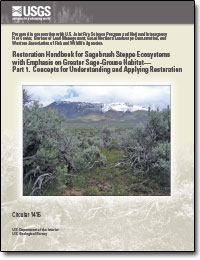Restoration handbook for sagebrush steppe ecosystems with emphasis on greater sage-grouse habitat—Part 1. Concepts for understanding and applying restoration
Links
- Document: Report (6.3 MB pdf)
- Related Works:
- Circular 1418 – Restoration handbook for sagebrush steppe ecosystems with emphasis on greater sage-grouse habitat—Part 2. Landscape level restoration decisions
- Circular 1426 – Restoration handbook for sagebrush steppe ecosystems with emphasis on greater sage-grouse habitat—Part 3. Site level restoration decisions
- Download citation as: RIS | Dublin Core
Abstract
Sagebrush steppe ecosystems in the United States currently occur on only about one-half of their historical land area because of changes in land use, urban growth, and degradation of land, including invasions of non-native plants. The existence of many animal species depends on the existence of sagebrush steppe habitat. The greater sage-grouse (Centrocercus urophasianus) is a landscape-dependent bird that requires intact habitat and combinations of sagebrush and perennial grasses to exist. In addition, other sagebrush-obligate animals also have similar requirements and restoration of landscapes for greater sage-grouse also will benefit these animals. Once sagebrush lands are degraded, they may require restoration actions to make those lands viable habitat for supporting sagebrushobligate animals. This restoration handbook is the first in a three-part series on restoration of sagebrush ecosystems. In Part 1, we discuss concepts surrounding landscape and restoration ecology of sagebrush ecosystems and greater sage-grouse that habitat managers and restoration practitioners need to know to make informed decisions regarding where and how to restore specific areas. We will describe the plant dynamics of sagebrush steppe ecosystems and their responses to major disturbances, fire, and defoliation. We will introduce the concepts of ecosystem resilience to disturbances and resistance to invasions of annual grasses within sagebrush steppe. An introduction to soils and ecological site information will provide insights into the specific plants that can be restored in a location. Soil temperature and moisture regimes are described as a tool for determining resilience and resistance and the potential for various restoration actions. Greater sage-grouse are considered landscape birds that require large areas of intact sagebrush steppe; therefore, we describe concepts of landscape ecology that aid our decisions regarding habitat restoration. We provide a brief overview of restoration techniques for sage-grouse habitat restoration. We conclude with a description of the critical nature of monitoring for adaptive management of sagebrush steppe restoration at landscape- and project-specific levels.
Suggested Citation
Pyke, D.A., Chambers, J.C., Pellant, M., Knick, S.T., Miller, R,F., Beck, J.L., Doescher, P.S., Schupp, E.W., Roundy, B.A., Brunson, M., and McIver, J.D., 2015, Restoration handbook for sagebrush steppe ecosystems with emphasis on greater sage-grouse habitat—Part 1. Concepts for understanding and applying restoration: U.S. Geological Survey Circular 1416, 44 p., https://dx.doi.org/10.3133/cir1416.
ISSN: 2330-5703 (online)
ISSN: 1067-084X (print)
Study Area
Table of Contents
- Preface
- Abstract
- Introduction
- Sagebrush Steppe Ecosystems
- Resilience to Disturbance and Resistance to Invasions by Annual Grasses in Sagebrush Steppe Ecosystems
- Soils and Ecological Site Descriptions—Roles in Restoration
- Restoration Actions
- Landscape as a Concept for Restoration
- Restoration Methods of Sagebrush Steppe Ecosystems for Sage-Grouse Habitat
- Monitoring and Adaptive Management
- Conclusions
- Acknowledgments
- References Cited
- Appendix A. Scientific Name with Synonyms and Corresponding Common Name with Synonyms for Species Referenced in This Report
| Publication type | Report |
|---|---|
| Publication Subtype | USGS Numbered Series |
| Title | Restoration handbook for sagebrush steppe ecosystems with emphasis on greater sage-grouse habitat—Part 1. Concepts for understanding and applying restoration |
| Series title | Circular |
| Series number | 1416 |
| ISBN | 9781411339682 |
| DOI | 10.3133/cir1416 |
| Publication Date | October 26, 2015 |
| Year Published | 2015 |
| Language | English |
| Publisher | U.S. Geological Survey |
| Publisher location | Reston, VA |
| Contributing office(s) | Forest and Rangeland Ecosystem Science Center |
| Description | vii, 43 p. |
| Country | United States |
| State | Arizona, California, Colorado, Idaho, Montana, Nebraska, Nevada, New Mexico, North Dakota, Oregon, South Dakota, Utah, Washington, Wyoming |
| Other Geospatial | Colorado Plateau, Columbia Basin, Great Basin, Silver Sagebrush, Snake River Plain, Wyoming Basin |
| Online Only (Y/N) | N |
| Additional Online Files (Y/N) | N |


